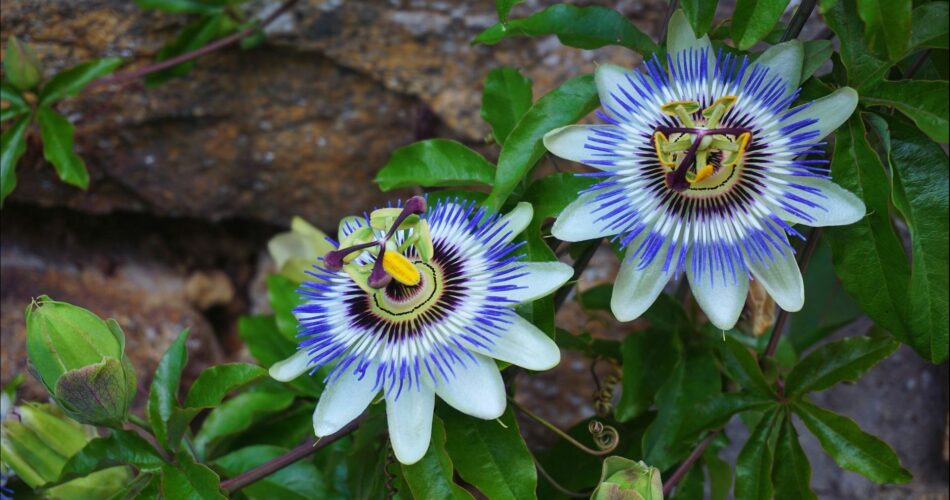Passionflowers (genus Passiflora) are renowned for their unique and exotic blooms, as well as their potential health benefits. Growing these captivating vines can be a rewarding experience, but it requires careful attention to their specific needs. In this expert guide, we’ll walk you through the essential steps to successfully cultivate passionflowers, drawing on guidance from government and horticultural bodies, as well as insights from academic experts.
Selecting the Right Passionflower Variety
Begin your passionflower journey by choosing a suitable variety for your climate and space. Different species thrive in various conditions. Consult resources from your local agricultural extension office or horticultural society for recommendations tailored to your region. Ensure the chosen variety is well-suited to your climate, soil type, and sunlight availability.
Site Selection and Soil Preparation
Passionflowers prefer well-drained soil with a slightly acidic to neutral pH (6.0-7.0). Before planting, test your soil and make amendments if necessary. Government agricultural extension offices often provide soil testing services. Select a sunny location, as passionflowers require full sunlight for optimal growth. Prepare the soil by incorporating organic matter, such as compost, to enhance fertility.
Planting Passionflower Seeds or Seedlings
From Seeds
If starting from seeds, follow the recommended planting depth and spacing on the seed packet. Soak seeds overnight to improve germination rates. Plant in spring after the last frost, keeping soil consistently moist until seedlings are established.
From Seedlings
For a quicker start, purchase healthy passionflower seedlings from reputable nurseries. Transplant them into well-prepared soil after the last frost, following spacing guidelines for the specific variety.
Watering and Fertilizing
Passionflowers require consistent moisture, especially during dry periods. Water deeply, allowing the soil to dry slightly between watering sessions. Apply a balanced, water-soluble fertilizer according to the recommendations on the product label. Avoid over-fertilization, as it can lead to excessive foliage growth at the expense of flower production.
Providing Support and Training
Passionflowers are vigorous climbers that benefit from support structures. Install trellises or arbors for them to climb. Gently train the vines as they grow, guiding them along the desired path. Be cautious not to damage the delicate tendrils.
Pest and Disease Management
Keep a vigilant eye for pests such as aphids and caterpillars. Monitor for signs of diseases like fungal infections or root rot. Consult local agricultural extension services for integrated pest management strategies and disease control measures appropriate for your region.
Pruning for Health and Productivity
Prune passionflowers judiciously to promote airflow, reduce disease risk, and encourage more blooms. Remove dead or diseased growth, and prune to shape the plant. Consult horticultural experts or university extension services for species-specific pruning guidelines.
Harvesting Passionfruit
Once your passionflower plant matures, it will produce exotic and aromatic flowers. Some varieties also bear edible fruit known as passionfruit. Harvest fruit when it turns color and slightly wrinkles. Check with local horticultural bodies for advice on the best time for harvesting passionfruit in your area.
Winter Care
In regions with frost, protect passionflowers during winter. Mulch around the base to insulate roots and consider covering the plant during freezing temperatures. Consult local gardening experts or government horticultural agencies for region-specific winter care recommendations.
Conclusion
Growing passionflowers requires attention to detail and adherence to best practices. Utilize resources from reputable government and horticultural bodies, as well as academic experts, to ensure success in cultivating these enchanting vines. By following these expert guidelines, you can create a thriving passionflower garden that rewards you with stunning blooms and, in some cases, delicious fruit.
What is a Passionflower, and why would I want to grow it?
Passionflower, scientifically known as Passiflora, is a beautiful flowering plant that is not only visually appealing but also has medicinal properties. Growing it can enhance your garden aesthetics and provide various health benefits.
Where can I grow Passionflowers, and what kind of climate do they prefer?
Passionflowers thrive in warm to tropical climates. They prefer full sun but can tolerate partial shade. Well-draining soil is essential for their growth, and they can be grown both in the ground and in containers.
How do I plant Passionflower seeds or cuttings?
Passionflower can be grown from seeds or cuttings. To grow from seeds, scarify them by gently scratching the seed coat, then soak them in water for a few hours before planting. Cuttings can be taken from mature plants and rooted in a well-draining soil mix.
What are the key care tips for Passionflowers?
Passionflowers require regular watering, especially during dry spells, but they don’t like waterlogged soil. Fertilize with a balanced, all-purpose fertilizer during the growing season. Prune the plant to control its size and shape and to encourage more blooms.
How long does it take for Passionflowers to bloom?
The time it takes for Passionflowers to bloom depends on the variety and growing conditions. Generally, you can expect flowers within the first year of planting. Some varieties may bloom in as little as four months, while others might take up to two years.
Do Passionflowers attract pollinators?
Yes, Passionflowers are known for attracting a variety of pollinators, including bees and butterflies. Their unique, intricate flowers are designed to entice and accommodate pollinators.
Can I grow Passionflowers indoors?
While Passionflowers are typically outdoor plants, some smaller varieties can be grown indoors in containers. Ensure they receive sufficient sunlight, and consider providing support for climbing varieties.
Are Passionflowers invasive?
Passionflowers can be vigorous growers, and some varieties may exhibit invasive tendencies. It’s crucial to monitor their growth and prune as needed to prevent them from spreading uncontrollably.
How do I protect Passionflowers from pests and diseases?
Passionflowers can be susceptible to aphids, caterpillars, and fungal diseases. Regularly inspect the plant for pests, and treat with insecticidal soap or neem oil if necessary. Ensure proper air circulation to reduce the risk of fungal issues.
Can I use Passionflowers for medicinal purposes?
Yes, Passionflowers have been traditionally used for their calming and sedative properties. However, it’s essential to consult with a healthcare professional before using them for medicinal purposes to ensure proper dosage and safety.
- Gardening Options for Fall and Winter - July 18, 2024
- 13 Top Greenhouse Gardening Benefits and Uses - July 18, 2024
- 10 Water Saving Tips For Your Garden - July 17, 2024




